Spanish solution
In railway and rapid transit parlance, the Spanish solution is a station layout with two railway platforms, one on each side of the track.[1] This platform arrangement allows the separation of passenger streams by using one platform only for boarding and the other one only for alighting.[1] The concept of separate platforms for boarding and alighting has been proven effective at stations with high passenger numbers.[2]
Spanish solution | |||||||||||||||||||||
|---|---|---|---|---|---|---|---|---|---|---|---|---|---|---|---|---|---|---|---|---|---|
|
| |||||||||||||||||||||
|
| |||||||||||||||||||||
Examples
The term "Spanish solution" derives from its use in several stations of the Madrid Metro (e.g. Avenida de América) and Barcelona Metro (e.g. Sant Andreu).
An example of the Spanish Solution is the Marienplatz station on the Munich S-Bahn, with island platform for boarding and side platforms for alighting.[3]
Gallery
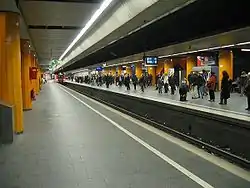 Eastbound track at Marienplatz station, Munich S-Bahn
Eastbound track at Marienplatz station, Munich S-Bahn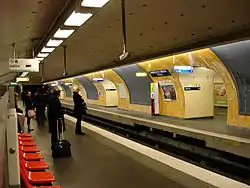 Spanish solution on Line 6 at Charles de Gaulle - Étoile. Paris Metro
Spanish solution on Line 6 at Charles de Gaulle - Étoile. Paris Metro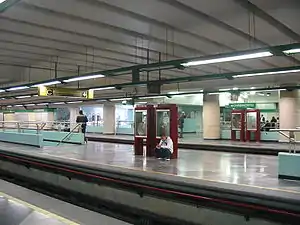
 Looking from one train through another, with doors open on both sides, to a third train. At Barking in London, England eastbound Underground trains open their doors on both sides for cross-platform interchange with two main-line services, C2C and London Overground Barking - Gospel Oak, this photograph from inside one of the latter.
Looking from one train through another, with doors open on both sides, to a third train. At Barking in London, England eastbound Underground trains open their doors on both sides for cross-platform interchange with two main-line services, C2C and London Overground Barking - Gospel Oak, this photograph from inside one of the latter.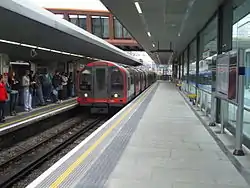 Westbound platforms 3 and 3a at Stratford station (with a London Underground Central line train arriving). Trains now open their doors on both sides at this platform.
Westbound platforms 3 and 3a at Stratford station (with a London Underground Central line train arriving). Trains now open their doors on both sides at this platform. Boston's Park Street Under station in 1912. The same platform configuration is still in use.
Boston's Park Street Under station in 1912. The same platform configuration is still in use.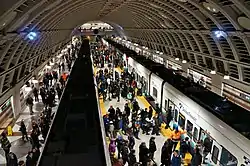 A temporary center platform at Pioneer Square station in Seattle used for transfers between trains
A temporary center platform at Pioneer Square station in Seattle used for transfers between trains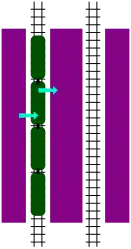 Spanish solution: the principle. Passengers board from the left platform, and alight in the middle island.
Spanish solution: the principle. Passengers board from the left platform, and alight in the middle island.
References
- Olshausen, Hans-Gustav (9 March 2013). VDI-Lexikon Bauingenieurwesen [VDI-Lexikon civil engineering] (in German) (2nd ed.). Springer-Verlag. p. 63. ISBN 978-3-642-48098-0.
- Fendrich, Lothar (25 January 2007). Handbuch Eisenbahninfrastruktur [Railway infrastructure handbook] (in German). Springer-Verlag. pp. 36, 37. ISBN 9783540317074.
- Walter, Dirk (1 April 2017). "So wird Münchens zweite S-Bahn-Röhre" [This is how Munich's second S-Bahn-tube will be like]. ovb-online.de (in German). Oberbayerisches Volksblatt GmbH & Co. Medienhaus KG. Retrieved 21 October 2018.
At least the new main train station stop and the Marienhof stop are being built with a "Spanish solution", ie with a central platform and an exit to the right for the rapid change of passengers (such as today on Stachus) [via Google automated German-English translation service].
External links
 Media related to Spanish solution at Wikimedia Commons
Media related to Spanish solution at Wikimedia Commons
This article is issued from Wikipedia. The text is licensed under Creative Commons - Attribution - Sharealike. Additional terms may apply for the media files.